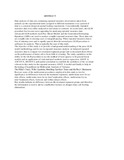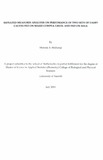| dc.description.abstract | Data analysis of data sets containing repeated measures observations taken from
animals (as the experimental units) assigned to different treatments over a period of
time is a common design in animal feeding experiments. Conventionally, repeated
measures data were either analyzed as univariate or contrasts. In recent times, the GLM
procedure has become more appealing for analyzing repeated measures data.
Advanced GLM methods such Proc Mixed Models and the Generalized Estimating
Equations (GEEs) are used to analyze complex repeated measures data. These data sets
are complex due to missing cases or unequal spacing. When repeated measures data is
free of missing cases and is equally spaced, then the normal proc GLM procedure is
sufficient for analysis. This is typically the case of this study.
The objective of this study is to provide a background understanding of the proc GLM
model methodology and its use in repeated measures analysis on balanced repeated
measures data to compare two treatment regiment groups and to document their effects
on the performance of dairy calves from birth to weaning. The study capitalizes on the
ability of the GLM procedure to use the method of least squares to fit general linear
models and its application of vital statistical methods such as regression, ANOV A,
ANCOVA, MANOVA and partial correlation to establish the usefulness of the covariate
(chosen in this study) in the repeated measures ANOV A model and finally to help in
the testing of hypotheses in Multivariate Analysis of Variance.
The Pillai's Trace, Wilks' Lambda, Hotelling-Lawleys' Trace and the Roy's Maximum
Root are some of the multivariate procedures employed in this study to test for
significance in differences between the treatment regiments, multivariate tests for no
time effects, multivariate tests for no time*replication effects, multivariate for no
time*treatment effects, between and within subject effects.
Key results indicate no difference between the treatment regiment groups and therefore
the information is used to advise smallholder farmers on cheaper dairy calf feeding
alternatives. | en |


